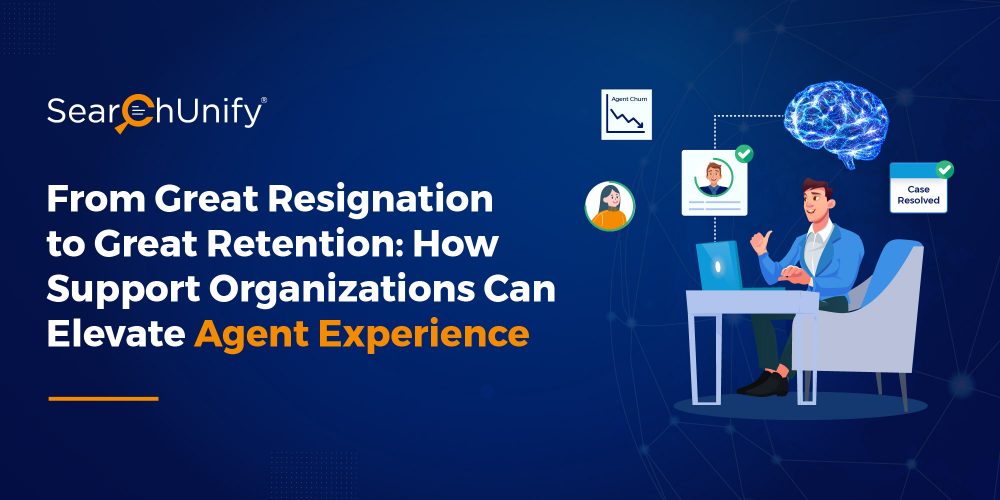
The seismic waves of the pandemic started eroding the shores of the workforce as they began quitting their jobs in droves. Call it an epiphany or a revolution, but many are certainly calling it a mass exodus or The Great Resignation.
Let’s revisit some facts. In 2021, more than 47 million voluntarily left their jobs. It wreaked havoc on the labor market back then and continues to haunt the organizations. Well, the latest survey from Gartner predicts the annual employee voluntary turnover is likely to reach 37.4 million in 2022, suggesting that “the Big Quit” is not over just yet.
Many industries are witnessing a surge of resignations even now. In the Customer Experience (CX) industry, 71% of service agents have considered quitting in the past six months. In fact, 69% are considering leaving customer service roles entirely. The numbers are quite sobering, aren’t they?
But this might make you ponder—did a protracted period of “sitting tight” during the pandemic function as an awakening for service reps of how much they dreaded their jobs? Or has this storm been brewing quietly all along, and 2021 was just the year when it reached a saturation point?
In this blog post, the challenges stemming from the workplace that contribute to agent attrition and understand how organizations can tackle them. Let’s get started.
Moment of Truth—The Great Resignation Didn’t Start with the Pandemic
Did you know that a typical day in the life of a service agent can be quite overwhelming? Be it troubleshooting complex tickets, handling disgruntled customers, maintaining knowledge bases, or answering repetitive customer inquiries—our superhero does it all and much more. That too, with a subpar tech stack! No wonder, nearly 74% of them are on the verge of occupational burnout.
According to the Harvard Business Review, the pandemic has created 68% more call escalations, 50% more difficult calls, and 34% longer hold times.
The cumbersome escalations with a mediocre tech stack become challenging. Not a pretty picture, right? Now, let’s dive deeper into the challenges that cast a dark shadow over support engineers.
Quantifying the Problems Faced by Service Agents
While CX became a top priority for umpteen organizations, the importance of Agent experience (AX) was neglected. As a result, the service teams often find themselves in murky waters. Here are some of the blockades faced:
1. Heavy & Repetitive Workloads
As mentioned earlier, the agents encounter overwhelming workloads on a daily basis. Their tasks range from repetitive to complex. Prolonged exposure to such environments is bound to be taxing, at times. This leads to occupational burnout.
2. Hard to Find Answers
When a ticket is assigned to an agent, the clock for providing an effective resolution starts ticking. However, 20% of the agent’s time is spent in the trenches finding the right contextual knowledge at the right time. Thanks to data silos! All this increases the TTR & reduces the agent productivity.
3. Insignificant Onboarding
It doesn’t matter how intricately the companies’ onboarding sessions are designed, the fresh recruits are bound to feel overwhelmed with the colossal amount of new information. On top of that, most of the training sessions are generalized and don’t cater to team-specific needs. Moreover, the new hires often hesitate to clear any doubts and prefer getting them resolved via company portals but that’s seldom the case.
4. Lack of Recognition
Recognizing employees for their spectacular performances is important in every organization. Well, everyone wants to feel appreciated and valued, isn’t it? The talented and top-performing agents seek appreciation after going through days of stress and chaos. But when that doesn’t happen, they feel the urge to switch to an employer that appreciates them.
5. Disrupted Communication & Limited Collaboration
Relying on virtual collaboration carries lingering concerns of lack of engagement, miscommunications, misunderstandings, and much more. Face-to-face setting leaves little room for errors as you understand your colleagues and the nuances of body language or gestures better. In other words, virtual collaboration lacks the loss of the personal touch of ‘being there.’
Clearly, this screams the need for some sort of support. Maybe, automation and artificial intelligence (AI) might be able to help. Well, I am not saying that. The service mavens are.
Salesforce suggests that 89% of agents feel more satisfied with their jobs using automation. In fact, it is reported to reduce errors in work (66%), lessen menial tasks in day-to-day work (47%), and help make faster decisions (86%). Color me amazed!
Making Your Service Agent’s Life Easier with Cognitive Technology
It’s high time that your support enterprise prioritizes the AX. Besides, developing an agent-centric environment only welcomes a whole flurry of customer service goodness within your company. So, how could you ameliorate your agent experience for good? Let’s dive in:
1. Automating Repetitive Tasks with Intelligent Chatbots
Imagine having a virtual assistant that’s available 24×7, handles repetitive customer inquiries, comes up with smart & case-resolving suggestions, and automates CRM entries. Spectacular, right?
If your support ecosystem is equipped with such a capable AI-powered chatbot, your service reps will have more bandwidth to work on complex tasks. Want more? Here are some additional ways they help augment agent productivity.
2. Finding Answers in One Place with a Unified View of Information
Data silos, oftentimes, hamstring your customer service efforts. However, you can say goodbye to them for good.
Some vendors offer native connectors to unify all the enterprise data that’s trapped across multiple platforms—website, blog, knowledge bases, discussion boards, documentation, and so on—which makes taming the data beast a five-finger exercise. Ultimately, it helps agents find information right on time.
3. Identifying & Prioritizing Escalations with Intelligent Triaging
When self-service falls short, the ball rolls into your service team’s court as a ticket. But what if the avalanche of tickets entrain snow over your agent? Questions such as which ticket needs to be solved first, which case to prioritize, and so on might make rounds. A mastodonic Intelligent Case Assignment might help.
It analyzes case data to gauge customer sentiment, type of issue, and the likelihood of escalation. Then, it intelligently prioritizes and routes the case to the best support maven for a speedy resolution, thus curtailing escalations.
4. Tapping into Customer Journey Insights with Real-time Analytics
A service agent’s life would be a lot easier if they understand the customers, identify their lifestyle, and predict the best action in real-time.
This is where real-time analytics emerges as sunshine. By leveraging NLU for intent detection and ML for data analysis, cognitive technology tracks user history and engagement patterns. Based on this data, it generates in-depth reports, surfaces the most relevant results, and turns your AX strategy into a tour de force.
5. Providing Proper Training with Effective Agent Onboarding
Your step towards exemplary agent experience starts on day 1. So, having consistent onboarding support at every step of the journey brings them up to speed real quick.
Cognitive apps might be able to help with that. They act as a training wheel and provide them with problem-solving knowledge from similar customer queries. This eliminates the struggle to find answers and train agents on the job.
6. Delivering Proactive Support with Intelligent Swarming
Not all resolutions reside in the knowledge bases. Some require the expertise of Subject Matter Experts (SMEs). Moving beyond the traditional models, the forward-thinking enterprises are opting for a collaborative approach—Intelligent Swarming.
Instead of keeping your customers in a waiting room limbo or ping-pong tickets from one agent to the next, it lets the assigned agent connect with SMEs on collaboration tools such as Slack to quickly find an effective resolution. Impeccable, right?
7. Increasing Engagement & Productivity with Gamification
To keep the spirits high and spur service agents, many companies are using gamification to reward them with incentives as they make progress. Rewards such as badges, certificates, and leaderboards can be specially curated.
Become the Agent of Change in Your Organization!

The “normal” we continue to pine for is gone forever. It is time to move ahead and leverage next-gen technologies to unlock AX success. But, at times, these techs sometimes fail to offer the connectivity and scalability you need to arm your support teams. Fret not; we could be of some use here.
Tune into our on-demand webinar where we share some impeccable strategies for building the ultimate agent desktop that streamlines and automates agent workflows. Hence, augmented AX further leads to exemplary CX. 🙂


















